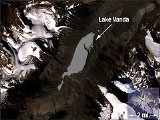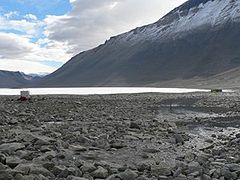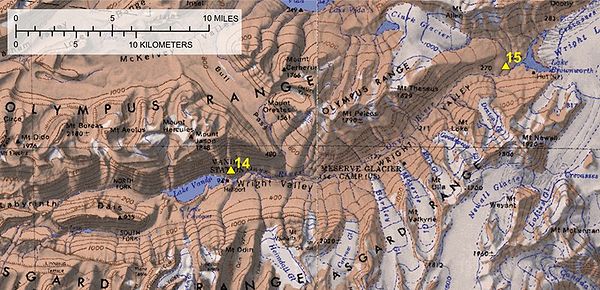
Lake Vanda
Encyclopedia
Lake Vanda is a lake
in Wright Valley
, Victoria Land
, Ross Dependency
, Antarctica. The lake is 5 km long and has a maximum depth of 69 m. On its shore, New Zealand
maintained Vanda Station
from 1968 to 1995. Lake Vanda is a hypersaline
lake with a salinity more than ten times that of seawater, more than the salinity of the Dead Sea
, and perhaps even more than of Lake Assal (Djibouti), which is the world's most saline lake outside of Antarctica. Lake Vanda is also meromictic
, which means that the deeper waters of the lake don't mix with the shallower waters. There are three distinct layers of water ranging in temperature from 23 °C (73.4 °F) on the bottom to the middle layer of 7 °C (44.6 °F) and the upper layer ranges from 4–6 °C (39.2–42.8 F). It is only one of the many saline lakes in the ice-free valleys of the Transantarctic Mountains
. The largest river
of Antarctica, Onyx River
, flows West, inland, into Lake Vanda. There is a meteorological station at the mouth of the river.
 The lake is covered by a transparent ice sheet 3.5–4 m (11.5–13.1 ft) year-round, though melting in late December forms a moat
The lake is covered by a transparent ice sheet 3.5–4 m (11.5–13.1 ft) year-round, though melting in late December forms a moat
out to approximately 50 metres (164 ft) from the shore. The surface of the ice is not covered with snow and is "deeply rutted with cracks and melt lines". During the colder months the moat refreezes.
While no species of fish
live in Lake Vanda or the Onyx River, microscopic life such as cyanobacteria algal blooms have been recorded. Due to the concerns over impact to the natural environment that may occur during research, scientific diving operations are limited to work in the upper layer (above 30 metres (98.4 ft)) and remotely operated underwater vehicle use is not allowed.
was well known for The Royal Lake Vanda Swim Club. Visitors to Lake Vanda Station could dip into the high salinity waters when the icecap edge melted out during summer to form a 'moat', and receive a Royal Lake Vanda Swim Club shoulder patch. Vanda staff would assist the melt by hacking out a 'pool'. Many dignitaries and politicians were inducted into the club, The dip had to be naked (Rule 1), complete immersion (Rule 4), witnessed by a 'Vandal' (Vanda Station staffer) and with no restrictions on photography (Rule 6) to qualify. Rule 10 allowed a natural figleaf, but it had to be natural and also naturally green without artificial aid.
Vanda Station was removed in 1995 as lake levels rose, and is replaced by a shelter, Lake Vanda Hut, that is periodically staffed by 2-8 stream researchers.

Lake
A lake is a body of relatively still fresh or salt water of considerable size, localized in a basin, that is surrounded by land. Lakes are inland and not part of the ocean and therefore are distinct from lagoons, and are larger and deeper than ponds. Lakes can be contrasted with rivers or streams,...
in Wright Valley
Wright Valley
The Wright Valley is the central one of the three large Dry Valleys in the Transantarctic Mountains, located west of McMurdo Sound at approximately . Wright Valley contains the Onyx River, the largest river in Antarctica, Lake Brownworth, the origin of Onyx River, and Lake Vanda, which is fed by...
, Victoria Land
Victoria Land
Victoria Land is a region of Antarctica bounded on the east by the Ross Ice Shelf and the Ross Sea and on the west by Oates Land and Wilkes Land. It was discovered by Captain James Clark Ross in January 1841 and named after the UK's Queen Victoria...
, Ross Dependency
Ross Dependency
The Ross Dependency is a region of Antarctica defined by a sector originating at the South Pole, passing along longitudes 160° east to 150° west, and terminating at latitude 60° south...
, Antarctica. The lake is 5 km long and has a maximum depth of 69 m. On its shore, New Zealand
New Zealand
New Zealand is an island country in the south-western Pacific Ocean comprising two main landmasses and numerous smaller islands. The country is situated some east of Australia across the Tasman Sea, and roughly south of the Pacific island nations of New Caledonia, Fiji, and Tonga...
maintained Vanda Station
Vanda Station
Vanda Station was an Antarctic research base in the western highlands of the Ross Dependency, specifically on the shore of Lake Vanda, at the mouth of Onyx River, in the Wright Valley...
from 1968 to 1995. Lake Vanda is a hypersaline
Salinity
Salinity is the saltiness or dissolved salt content of a body of water. It is a general term used to describe the levels of different salts such as sodium chloride, magnesium and calcium sulfates, and bicarbonates...
lake with a salinity more than ten times that of seawater, more than the salinity of the Dead Sea
Dead Sea
The Dead Sea , also called the Salt Sea, is a salt lake bordering Jordan to the east and Israel and the West Bank to the west. Its surface and shores are below sea level, the lowest elevation on the Earth's surface. The Dead Sea is deep, the deepest hypersaline lake in the world...
, and perhaps even more than of Lake Assal (Djibouti), which is the world's most saline lake outside of Antarctica. Lake Vanda is also meromictic
Meromictic
A meromictic lake has layers of water that do not intermix. In ordinary, "holomictic" lakes, at least once each year there is a physical mixing of the surface and the deep waters...
, which means that the deeper waters of the lake don't mix with the shallower waters. There are three distinct layers of water ranging in temperature from 23 °C (73.4 °F) on the bottom to the middle layer of 7 °C (44.6 °F) and the upper layer ranges from 4–6 °C (39.2–42.8 F). It is only one of the many saline lakes in the ice-free valleys of the Transantarctic Mountains
Transantarctic Mountains
The three largest mountain ranges on the Antarctic continent are the Transantarctic Mountains , the West Antarctica Ranges, and the East Antarctica Ranges. The Transantarctic Mountains compose a mountain range in Antarctica which extend, with some interruptions, across the continent from Cape Adare...
. The largest river
River
A river is a natural watercourse, usually freshwater, flowing towards an ocean, a lake, a sea, or another river. In a few cases, a river simply flows into the ground or dries up completely before reaching another body of water. Small rivers may also be called by several other names, including...
of Antarctica, Onyx River
Onyx River
The Onyx River is a meltwater stream which flows westward through the Wright Valley from Wright Lower Glacier and Lake Brownworth at the foot of the glacier to Lake Vanda, during a few months of the Antarctic summer....
, flows West, inland, into Lake Vanda. There is a meteorological station at the mouth of the river.

Moat
A moat is a deep, broad ditch, either dry or filled with water, that surrounds a castle, other building or town, historically to provide it with a preliminary line of defence. In some places moats evolved into more extensive water defences, including natural or artificial lakes, dams and sluices...
out to approximately 50 metres (164 ft) from the shore. The surface of the ice is not covered with snow and is "deeply rutted with cracks and melt lines". During the colder months the moat refreezes.
While no species of fish
Fish
Fish are a paraphyletic group of organisms that consist of all gill-bearing aquatic vertebrate animals that lack limbs with digits. Included in this definition are the living hagfish, lampreys, and cartilaginous and bony fish, as well as various extinct related groups...
live in Lake Vanda or the Onyx River, microscopic life such as cyanobacteria algal blooms have been recorded. Due to the concerns over impact to the natural environment that may occur during research, scientific diving operations are limited to work in the upper layer (above 30 metres (98.4 ft)) and remotely operated underwater vehicle use is not allowed.
Vanda Station
Lake Vanda StationVanda Station
Vanda Station was an Antarctic research base in the western highlands of the Ross Dependency, specifically on the shore of Lake Vanda, at the mouth of Onyx River, in the Wright Valley...
was well known for The Royal Lake Vanda Swim Club. Visitors to Lake Vanda Station could dip into the high salinity waters when the icecap edge melted out during summer to form a 'moat', and receive a Royal Lake Vanda Swim Club shoulder patch. Vanda staff would assist the melt by hacking out a 'pool'. Many dignitaries and politicians were inducted into the club, The dip had to be naked (Rule 1), complete immersion (Rule 4), witnessed by a 'Vandal' (Vanda Station staffer) and with no restrictions on photography (Rule 6) to qualify. Rule 10 allowed a natural figleaf, but it had to be natural and also naturally green without artificial aid.
Vanda Station was removed in 1995 as lake levels rose, and is replaced by a shelter, Lake Vanda Hut, that is periodically staffed by 2-8 stream researchers.


